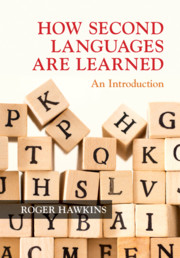41 results
Chapter 2 - The Intertidal Zone of the North-East Atlantic Region
-
-
- Book:
- Interactions in the Marine Benthos
- Published online:
- 07 September 2019
- Print publication:
- 29 August 2019, pp 7-46
-
- Chapter
- Export citation
Preface
-
- Book:
- How Second Languages are Learned
- Published online:
- 12 December 2018
- Print publication:
- 22 November 2018, pp xvii-xviii
-
- Chapter
- Export citation
Glossary
-
- Book:
- How Second Languages are Learned
- Published online:
- 12 December 2018
- Print publication:
- 22 November 2018, pp 303-310
-
- Chapter
- Export citation
Acknowledgements
-
- Book:
- How Second Languages are Learned
- Published online:
- 12 December 2018
- Print publication:
- 22 November 2018, pp xix-xx
-
- Chapter
- Export citation
List of Tables
-
- Book:
- How Second Languages are Learned
- Published online:
- 12 December 2018
- Print publication:
- 22 November 2018, pp xiii-xvi
-
- Chapter
- Export citation
References
-
- Book:
- How Second Languages are Learned
- Published online:
- 12 December 2018
- Print publication:
- 22 November 2018, pp 311-325
-
- Chapter
- Export citation
6 - How Phrasal and Sentential Meaning are Learned
-
- Book:
- How Second Languages are Learned
- Published online:
- 12 December 2018
- Print publication:
- 22 November 2018, pp 137-160
-
- Chapter
- Export citation

How Second Languages are Learned
- An Introduction
-
- Published online:
- 12 December 2018
- Print publication:
- 22 November 2018
-
- Textbook
- Export citation
Index
-
- Book:
- How Second Languages are Learned
- Published online:
- 12 December 2018
- Print publication:
- 22 November 2018, pp 326-328
-
- Chapter
- Export citation
Frontmatter
-
- Book:
- How Second Languages are Learned
- Published online:
- 12 December 2018
- Print publication:
- 22 November 2018, pp i-iv
-
- Chapter
- Export citation
3 - Exploring the L2 Learning of English Verb Forms
-
- Book:
- How Second Languages are Learned
- Published online:
- 12 December 2018
- Print publication:
- 22 November 2018, pp 49-69
-
- Chapter
- Export citation
7 - How Sound Systems are Learned
-
- Book:
- How Second Languages are Learned
- Published online:
- 12 December 2018
- Print publication:
- 22 November 2018, pp 161-190
-
- Chapter
- Export citation
11 - Pulling the Threads Together – a Theory of How Second Languages are Learned?
-
- Book:
- How Second Languages are Learned
- Published online:
- 12 December 2018
- Print publication:
- 22 November 2018, pp 282-302
-
- Chapter
- Export citation
List of Figures
-
- Book:
- How Second Languages are Learned
- Published online:
- 12 December 2018
- Print publication:
- 22 November 2018, pp xii-xii
-
- Chapter
- Export citation
1 - Second Language Learning: the Nature of the Task
-
- Book:
- How Second Languages are Learned
- Published online:
- 12 December 2018
- Print publication:
- 22 November 2018, pp 1-23
-
- Chapter
- Export citation
9 - The Role of Input in Second Language Learning
-
- Book:
- How Second Languages are Learned
- Published online:
- 12 December 2018
- Print publication:
- 22 November 2018, pp 222-249
-
- Chapter
- Export citation
8 - Real-Time and Contextual Use of Language by Second Language Speakers
-
- Book:
- How Second Languages are Learned
- Published online:
- 12 December 2018
- Print publication:
- 22 November 2018, pp 191-221
-
- Chapter
- Export citation
Dedication
-
- Book:
- How Second Languages are Learned
- Published online:
- 12 December 2018
- Print publication:
- 22 November 2018, pp v-vi
-
- Chapter
- Export citation
4 - How Sentence Structure is Learned
-
- Book:
- How Second Languages are Learned
- Published online:
- 12 December 2018
- Print publication:
- 22 November 2018, pp 70-112
-
- Chapter
- Export citation
5 - Second Language Learning and Universal Grammar
-
- Book:
- How Second Languages are Learned
- Published online:
- 12 December 2018
- Print publication:
- 22 November 2018, pp 113-136
-
- Chapter
- Export citation



